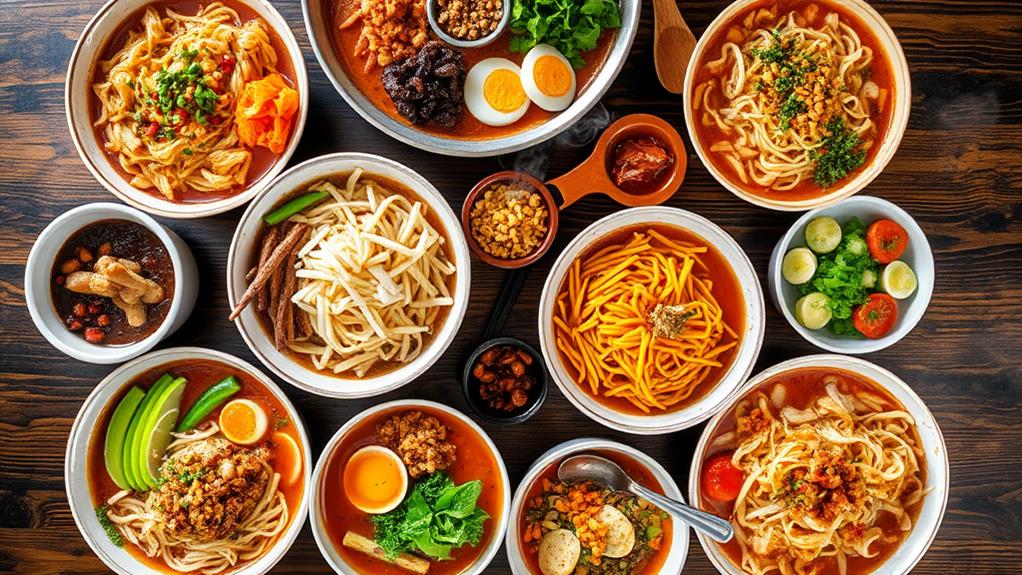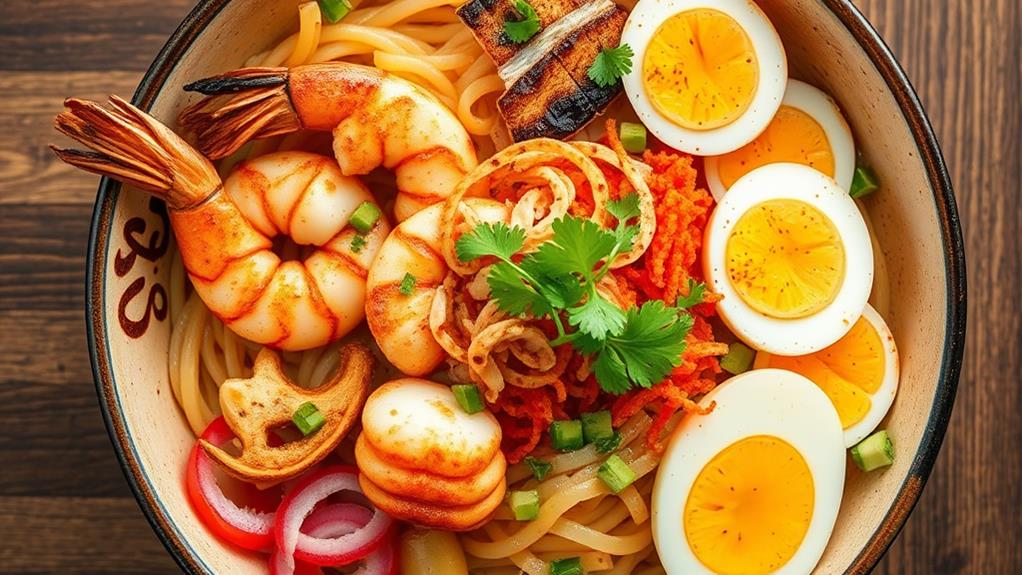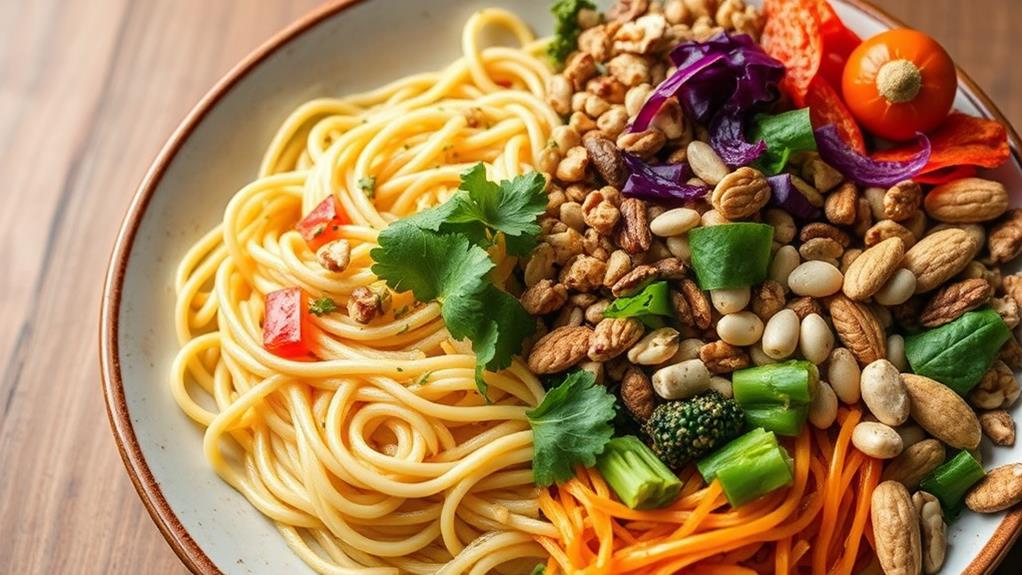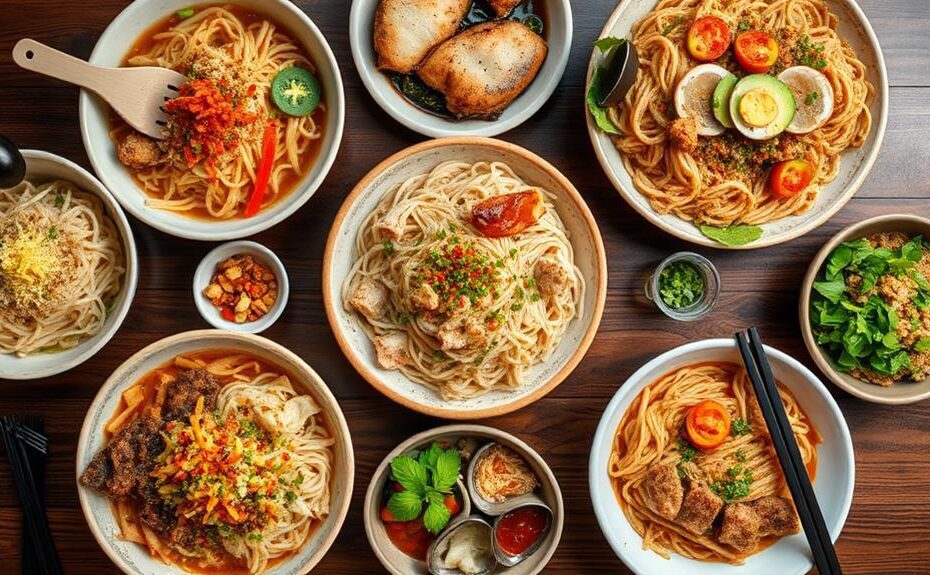Palabok noodles come in a variety of forms, each offering a distinct texture and flavor profile. Traditional options include bihon, cornstarch, and rice noodles.
Modern twists feature soba, kelp, or shirataki noodles, which introduce new textures and flavors to the dish.
Regional variations of Palabok noodles also exist. Pancit Malabon features thick, tubular rice noodles and seafood toppings, while Pancit Luglug uses thicker cornstarch noodles.
For those with dietary restrictions, vegetarian options use vegetable or soba noodles, and low-carb options use kelp or shirataki noodles.
These variations allow more people to enjoy this beloved Filipino dish.
Exploring Palabok Noodle Variations

Noodle type affects the character of Palabok dishes. The type of noodle used in Palabok variations significantly impacts the overall texture and flavor of the dish. For instance, Pancit Palabok typically uses bihon noodles, thin rice noodles that absorb the rich sauce well, creating a delightful texture.
In contrast, Pancit Luglug uses thicker cornstarch noodles, resulting in a different mouthfeel and a heartier dish.
Regional variations offer distinct twists. Pancit Malabon, for example, features thick, tubular rice noodles and often includes a greater variety of seafood toppings, making it a more seafood-centric option.
Vegetarian and low-carb options are possible. To cater to dietary restrictions, you can make vegetarian versions of Pancit Palabok using vegetable noodles or soba noodles.
Alternatively, experiment with kelp noodles or shirataki noodles for a low-carb alternative while maintaining the essence of the dish. These variations not only change the texture and flavor but also open up new possibilities for customization and creativity.
Regional Twists and Flavor Profiles
Regional variations of Palabok dishes showcase distinct characteristics shaped by local ingredients and cooking techniques.
Pancit Malabon, for example, features thick, tubular rice noodles and is often topped with a variety of savory seafood, making it a heartier dish rich in flavors and textures. This variation uses local ingredients like crab fat or squid, which enhance the flavor profile and reflect the culinary diversity across the Philippines.
Thicker cornstarch noodles are used in Pancit Luglug, offering a different texture compared to the thin bihon noodles used in traditional Pancit Palabok.
Regional variations also influence the use of local ingredients, such as annatto powder for added color and flavor or shrimp sauce for an umami boost.
Some variations even use crushed chicharon as a garnish, adding a satisfying crunch to the dish. These regional twists and flavor profiles demonstrate the versatility of this beloved Filipino dish.
Creative Toppings and Garnishes

Elevate Your Palabok with Creative Toppings and Garnishes
When it comes to customizing your Palabok, the possibilities are endless. Adding boiled eggs, crispy fried tofu, and sautéed vegetables introduces varied textures and flavors to the dish.
For a luxurious twist, incorporate seafood options like squid rings, mussels, or crab to elevate your Pancit Palabok.
Crunchy Elements and Freshness
Crumbling chicharrón (pork crackling) on top adds umami and a satisfying crunch to each bite.
A sprinkle of green onions or chopped parsley not only adds a pop of color but also enhances the freshness of the dish.
Sauces and Drizzles
Experiment with sauces like spicy vinegar or calamansi juice as a drizzle to provide a tangy contrast to the rich flavors of the Pancit Palabok.
Cooking Techniques and Tips
Mastering the Art of Cooking Palabok
To achieve the perfect texture in Palabok, soak bihon noodles in water for 15-30 minutes before boiling. This prevents the noodles from becoming mushy.
When preparing the sauce, sauté garlic and onion before adding ground pork. This enhances the depth of flavor in the dish. Using shrimp stock or broth derived from boiling shrimp creates a rich and flavorful sauce that complements the noodles.
Cooking Palabok Noodles
To cook the noodles, boil enough water and monitor the cooking time closely, as they typically only require about 1-2 minutes of boiling. This achieves the perfect texture.
Thickening the Sauce
To thicken the sauce, mix cornstarch with water to make a slurry, then add it to the simmering sauce until the desired consistency is achieved.
What types of variations can be made with Palabok noodles?
Palabok noodles production process has resulted in a variety of delicious variations. From adding different seafood toppings like shrimp and squid to experimenting with alternative sauces and garnishes, there are endless possibilities to elevate the traditional palabok noodles dish. Whether it’s spicy, tangy, or savory, the options are endless.
Nutritional Insights and Adaptations

What Makes Palabok a Satisfying Meal Option?
Palabok is a filling and delicious meal option due to its combination of flavors and nutrients. A typical serving of Pancit Palabok contains approximately 564 calories, with 74g of carbohydrates, 32g of protein, and 14g of fat.
However, it's essential to consider the dish's 289mg cholesterol level and 1376mg sodium content.
Healthier Adaptations to Consider:
To make Palabok a healthier option, consider the following adaptations:
Ingredient Substitutions: Using chicken instead of pork reduces fat content, while adding more vegetables increases vitamin intake.
Different Noodles: Switching to bihon or thicker cornstarch noodles affects the overall calorie count and nutritional profile.
Vegetable Broth: Replacing pork broth with vegetable broth significantly lowers the dish's fat and cholesterol content.
Reducing Chicharrón: Limiting the amount of chicharrón decreases fat content and calorie count.
Frequently Asked Questions
What Is the Difference Between Palabok and Luglug?
The main difference between Palabok and Luglug lies in their noodle preparation.
Palabok uses thin rice noodles, whereas Luglug employs thicker cornstarch noodles.
This variation affects the sauce, with Palabok's vibrant orange sauce and Luglug's slightly thicker consistency.
Regional differences in toppings also exist, with Luglug often featuring a diverse seafood selection.
These distinctions showcase the rich cultural heritage of Filipino cuisine, highlighting the importance of texture, flavor, and ingredient choices in defining these beloved dishes.
What Is the Best Match for Palabok?
Thin rice noodles, like bihon, are the best match for Palabok. They expertly absorb the rich shrimp and pork sauce, allowing for a harmonious balance of flavors. This is because thin rice noodles have a delicate texture that won't overpower the flavors of the sauce.
As a result, each bite is a perfect blend of savory and sweet notes.
This classic combination also opens up a world of possibilities for toppings. For example, you can add protein choices like pork belly or chicken to increase the dish's heartiness.
Additionally, garnishing ideas like green onions and fried shallots can add a burst of freshness and crunch to each serving. This flexibility makes each serving a flavorful and festive presentation.
What Is the Difference Between Pancit Palabok and Malabon?
Pancit Palabok and Malabon are two distinct variations of Pancit in Filipino cuisine.
Pancit Palabok features thin noodles, a rich shrimp-pork sauce, and layered toppings. This dish is often served at celebrations, showcasing its cultural significance. The thin noodles allow the flavorful sauce to coat each strand, while the layered toppings add texture and visual appeal.
Malabon, on the other hand, boasts thicker noodles and a seafood-based sauce. It's typically enjoyed as comfort food, with mixed toppings that complement the heartier noodles. The thicker noodles hold up to the chunky seafood sauce, creating a satisfying and filling meal.
The differences in sauce thickness, cooking methods, and serving styles result in unique flavor profiles and ingredients lists for each dish.
What Are the Different Types of Pancit Noodles?
Pancit noodles come in various types, each with distinct characteristics.
Pancit Bihon is a type of pancit made from thin rice noodles, often used in Palabok.
Pancit Canton, on the other hand, is made from wheat noodles similar to chow mein.
Thicker rice noodles can be found in Pancit Malabon, which has a tubular shape.
Pancit Sotanghon, however, is made from mung bean noodles.
Other types of pancit noodles include Pancit Habhab, Miki, Puti, Lomi, and Guisado, each offering unique flavors and textures.
